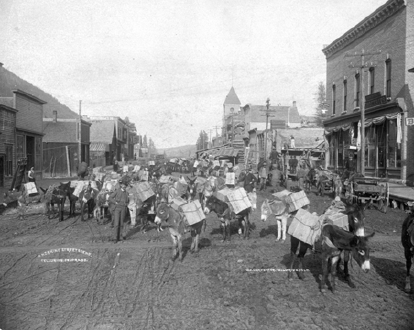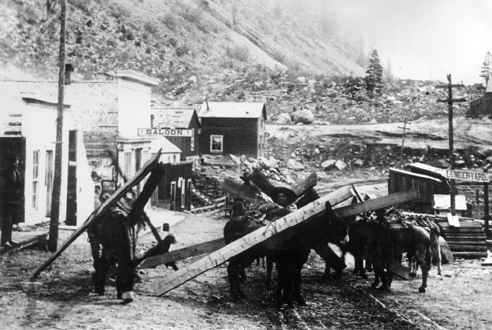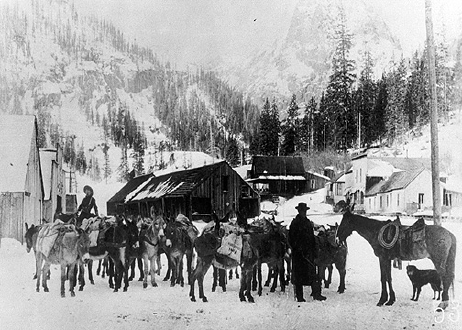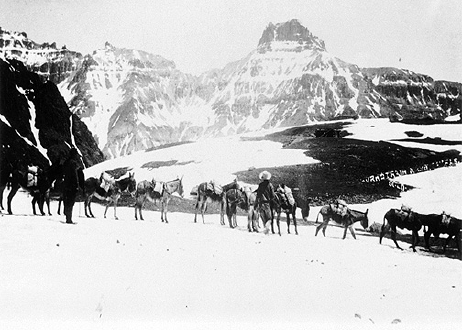Pack Trains
What do these photos tell you about how early mining camps got their supplies?
Pack Train In Telluride
This is a pack train of burros loaded with wooden boxes. The photo was taken in Telluride sometime during the 1890s.

Photo: Denver Public Library, Western History Collection
More About This Topic
Many of the smaller mines in Colorado were high in the mountains. They could not be reached by railroad or wagon road. The owners of those mines used pack trains of burros or mules to haul in supplies.
Their Own Words
". . . I took our burro, which was eating its head off, and packed grub to the Highland Mary Mine. Usually I could make two trips a day, pack a load up and ride the burro back, at $3.50 a load. For a fourteen-year-old boy, I made good wages."
Source: Robert Born (1934), CWA Interview Doc. 8/349, Colorado Historical Society.
Hauling Timbers In Silver Plume
The man in this photo is loading burros with wooden planks. The photo was taken at a lumberyard in Silver Plume, a town near Georgetown.

Photo: Denver Public Library, Western History Collection
More About This Topic
Burros were very useful animals. Miners used them haul lumber and supplies up to the mines. They also used them to haul ore out of the mines.
Their Own Words
"Wood is brought to market on the backs of pack mules (a beast scarcely three feet high [indicating these animals were actually burros]) and sells for 25 cents per load. It is astonishing to see how the little beasts are burdened. . . . when the little fellows come to market, with their burdens of hay and wool, one would be at a loss to find the motive power, as they are completely enveloped in the commodity, head and ears, and that is saying a good deal."
Source: “T,” “A Michigan Correspondent in Colorado, 1878,” Sidney Glazer, ed., Colorado Magazine, 37 (July 1960): 211.
Pack Train At a Mining Camp
This photo shows a pack train of burros at a mine in the mountains. They are loaded with packs filled with gold or silver ore.

Photo: Colorado Historical Society
More About This Topic
Miners used pack trains to haul ore from mines high in the mountains to smelters. The smelters removed the gold or silver from the quartz rock.
Their Own Words
"Most pack animals are interesting creatures. I remember one that always wanted to be in the lead on a trail, for she liked to set the pace. Another would go regularly to the cook tent after each meal for the garbage. One year in camp, we had a very canny little mule that seemed to know when moving day was coming, for on such occasions she would wander away from the other animals very early in the morning and hide."
Source: Wallace W. Atwood, The Rocky Mountains (New York: The Vanguard Press, 1945): 58.
Pack Train Near Silverton
This pack train of burros was photographed near Silverton. The burros probably were hauling ore down the mountain.

Photo: Colorado Historical Society
More About This Topic
This photo shows a pack train high in the mountains. The highest mines in Colorado were above timberline. Using pack trains of burros was the only way to haul the gold or silver ore down the mountain to the smelters. Burros were often also the only way to bring in supplies and fuel to the mining camps.
Their Own Words
“A bad pack animal is a terrible problem. He may refuse to stand while the pack is being put into place and may, at any moment, begin to buck the load off. I have seen cereals, hams, bacon, eggs, condensed milk, sugar, flour, and camp dishes go shooting in all directions and spilling down the hill because some pack animal misbehaved.”
Source: Wallace W. Atwood, The Rocky Mountains (New York: The Vanguard Press, 1945): 60.

